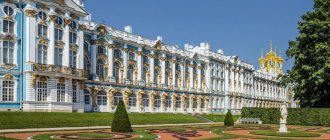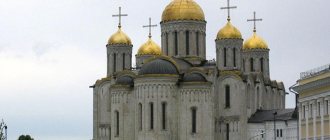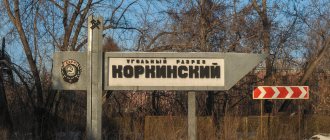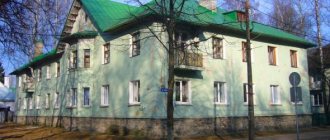This toponym has other meanings, see Obluchye (meanings).
| City Obluchye A country
|
| : Incorrect or missing image |
K: Settlements founded in 1911
Obluche
(Yiddish אָבלוטשיע[2]) is a city (since 1938) in Russia, the administrative center of the Obluchensky district of the Jewish Autonomous Region.
Population - 8792[1] people. (2016).
Story
The city was founded in 1911 by the builders of the Amur Railway under the name Sololi (from the Bolshaya and Malaya Sololi rivers that flowed nearby). Over the course of 4 years, the 200-meter Obluchensky tunnel (one of the seven Khingan tunnels) and the Obluchye railway station were built, under which tons of soil were poured under the park tracks. In 1915, the connection between the first and second sections of the Amur Railway took place here, completing its construction (only the bridge across the Amur remained uncommissioned). It was then that Obluchye received its modern name.
The status of an urban settlement was assigned in 1928, the status of a city - in 1938.
LiveInternetLiveInternet
The history of the city is closely connected with the construction of the Trans-Siberian Railway. In April 1911, a group of specialists left St. Petersburg for final research and construction of the third section of the eastern part of the Amur Railway.
In June, the detachment landed in the village of Pashkovskaya, from where the builders moved to the site of the future Sololi station, as the future Obluchye was originally dubbed.
Log buildings did not appear in Obluchye soon. The builders lived in tents until the winter. At first, only the bakery was cut down, then several barracks with solid bunks. By the end of the survey work, the main construction distances had been determined: Lagar-Aul, Kimkan, Kuldur and one in Sololi (from the name of the B. and M. Sololi rivers), which was managed by the engineer Leskhov. It was this distance that was destined to become a city. On February 17, 1915, the rails were joined at the station, and the Obluchensky section of the railway was put into operation.From that time on, the Obluchensky locomotive depot began to function.
The history of the city is inextricably linked with the history of the locomotive depot. His team has traveled a long and difficult path, from the first low-power steam locomotives to modern electric locomotives.
In 1936, on the site of a wooden church (Railway Traveling Church of the Obluchye station), a two-story signaling and communications building was built. On October 20, 1938, the workers' village of Obluchye received the status of a city, and in 1945 it became the center of the Obluchensky (formerly Birsky) district. The city lived the life of a large railway junction: there was a locomotive and carriage depot, workshops and other line enterprises. Most of the city's working population is connected with the railroad. Irradiation railway workers were the first in the Far East to drive heavy trains.
Food and light industry enterprises were also created. Currently, the city's industry is represented by enterprises producing bakery products, dairy products, sewing and repairing clothes and shoes; There is a section of the production association "Vostokelektroremont", a printing house, and a 220 kW transformer substation. special agricultural enterprise. state industrial enterprise, bee farm, construction organizations.
In 1967, an automatic telephone exchange with 600 telephone numbers was built in Obluchye.
There are 5 schools in the city, incl. The largest boarding school in the Far Eastern Railway department with 900 places.
This is one of the oldest schools in the city - school No. 3 in Obluchye. By the way, there was a small but quite interesting museum there, created through the efforts of students and teachers..
More than 10 thousand specialists for the railway graduated from the oldest educational institution in the city, PU-6, which was opened in 1914.
Obluchye is the cultural and sports center of the region - there is a music school, a children's aesthetic center, a club with 500 seats, two cinemas, a library, a ski lodge and a sports ground. Since 1935, the regional newspaper “Iskra Khingan” has been published. This is a reference to the history of the city of Obluchye, prepared within the walls of the regional library. And now I’ll tell you a little about the monuments that I saw during my trip. I’ll start with the monument to V.I., traditional in the past for all Soviet cities. Lenin. It stands at the central point of the city - the railway station.
But not in the center, as it would have been before, being the first to meet those who come to the city, and not on the small station square (fast site), but modestly nestled somewhere on the side of the building. To see it you need to specifically walk around the station building.
Such a small, cozy, intimate Ilyich stands on a green area fenced on three sides by station walls. Well camouflaged! Installed in 1970
Not far from the station, in the upper part of the city, on a small asphalt area, which is proudly called the central square, there are two more monuments.
This is a Monument in honor of fellow countrymen who died during the Great Patriotic War, also erected in 1970. This is my photo.
And this, much clearer, is from gazetaeao.ru. This is where ceremonies take place
And nearby, on the same square, there is another monument, erected much earlier and dedicated to the earlier tragic history of the Far East - the Civil War and intervention.
Monument to the partisans tortured by the Japanese-American interventionists in December 1919. That’s what it says on it
“Eternal glory to the partisan heroes who died in the fight against the American-Japanese invaders for the freedom and independence of our Motherland.” Please note that staged during the years of Soviet power, it glorifies the heroes not for the fight against the whites, who also dealt quite cruelly with the underground fighters and partisans operating in the territory of the Obluchensky region, but with the interventionists, separating internal strife from the more important thing - the independence of Russia, belonging to the Far East. American and Japanese invaders especially tried to control the Trans-Siberian Railway. I especially remember the cruelty of the Japanese. Today they don’t particularly remember this, but in my childhood there were still eyewitnesses to those events.
Before moving on to another, in my opinion, attraction of Obluchye, I will mention a sign that I have not seen, but which can also be considered a monument; I found a photo of it on the Internet.
Installation of a cross in the city of Obluchye at the site of the proposed construction of a temple (2005).
Well, personally, I found the railway station itself quite interesting - green, cozy, decorated with picturesque works.
old photos from here - https://obluchye.eao.ru/city/history.php
Geography
The city is located on the Khingan River (a tributary of the Amur), 159 km from Birobidzhan, on the border with the Amur region. A railway junction on the Trans-Siberian Railway, which here makes a large loop between the hills in the form of an irradiation (which is where one of the versions of the name of the former village, now the city, comes from).[16] Due to the fact that the city is closed from the north by mountains, the microclimate of the area is very favorable.
From west to east the city is surrounded by hills. In the north, the mountains come closer together, leaving a narrow passage for the Khingan River. From the south the city is bordered by a wide swampy plain.
A satellite of the city of Obluchye is the village of Yadrino, Amur Region, the distance along the Amur highway is about 2 km, directly - the southern part of the city and the village are separated by the Khingan River.
Climate
The climate in this area is monsoonal - winters are dry and cold, summers are humid and warm. The average temperature in January is minus 25 °C, in July - plus 20 °C.
The waters of the Khingan River are used mainly for the needs of the station; the population of the city is supplied with groundwater.
- Average annual air temperature - −0.6 °C
- Relative air humidity - 70.2%
- Average wind speed - 1.8 m/s
| Climate of Obluchye | |||||||||||||
| Index | Jan. | Feb. | March | Apr. | May | June | July | Aug. | Sep. | Oct. | Nov. | Dec. | Year |
| Average temperature, °C | −25,1 | −20 | −9,3 | 2,9 | 10,7 | 16,7 | 19,9 | 18,0 | 11,4 | 1,5 | −12,2 | −23 | −0,6 |
| Source: [www.retscreen.net/ru/home.php NASA. RETScreen Database] | |||||||||||||
Obluchye
Foundation of the railway village
The city of Obluchye traces its history back to the summer of 1911, when in June the first group of builders arrived in the village of Pashkovskaya, led by the young technician Joseph Arsenievich Mulin. The young builders had no idea about the Amur and the taiga; they were delighted with the untouched wild nature. It took the first builders three days to get from the village of Pashkovskaya to the site of the future city and the future Sololi station. The name “Sololi” comes from the rivers flowing nearby – Bolshaya and Malaya Sololi. Workers had to cut a clearing in the taiga with axes in order to drag carts with things, tools and provisions on horses.
Booths and tents were erected in the Khingan River valley. Among the builders were students from the western regions of Russia and Ukraine, including from Moscow and St. Petersburg, who came to work. People's work was hard, they had to work from dawn to dusk for meager pay, and the only tools they had were a shovel, a pick, a wheelbarrow and a stretcher. Sololi station was built from larch and cedar, which grew on the slopes of the hills surrounding the valley. Until the end of 1911, workers had to live in tents. By the end of the year, a bakery, a bathhouse and several barracks equipped with solid bunks were built.
Soon the first street with village houses appeared. At the suggestion of workers, graduates of the St. Petersburg Technological Institute, it was decided to name the first street Nevsky Prospekt, although if you move ten meters to the side, it’s an untrodden taiga. Today it is difficult to determine where that Nevsky Prospect is now. Nowadays the city of Obluchye is divided by railway into two parts. In the upper part of the city there is the main street - 30 Let Pobeda, formerly called Vokzalnaya. Perhaps this is that Nevsky? However, Denisova Street, which runs in the lower part of Obluchye and received its name in honor of the border guard of the Raddevskaya outpost, a hero who died during the conflict with Japanese border violators, may also be the former Nevsky Prospekt. There are old buildings on both streets: in the upper part there are four-apartment one-story houses, in the lower part there are two-story apartment buildings. But all these buildings date back to the 40s.
After laying a track along the slopes of the hills, bypassing the length of the Khingan River, the Sololi station was renamed Obluchye. Where did this name come from? In this place, the railway track curved, resembling the beam of a cab, which is probably where the name of the city came from. There was only one paramedic in the entire village, he was the German Bug, who, according to the old-timers, knew only a few words in Russian, and the paramedic did not know his job well. Therefore, it is not surprising that in those years those who suffered from pneumonia rarely recovered. Hard work and lack of medical care led to the death of many dozens of people.
Until 1915, in just 4 years, the builders built the station, only carrying millions of tons of soil under the park tracks, and the 200-meter Obluchensky tunnel was built. This was a real feat of people. On February 12, 1914, the laying of rails was completed on the entire middle section of the Amur Railway; workers connected the middle section with the Eastern part of the Amur Railway. This day is considered to be the birthday of the route. In 1915, the Obluchensky section of the road was put into operation. The Emperor's viceroy in the Far East, Nikolai Lvovich Gondati, cut the red ribbon on the bridge, and the Ov-14 steam locomotive pulled the train of 4 cars towards Khabarovsk.
Obluchye after the revolution
In 1918, construction of a locomotive depot began, which took place in incredibly difficult conditions. In 1918, the Obluchye station was captured by the Japanese. The White Guards carried out real terror, arrested innocent people, tortured them and killed them.
Obluchye station became one of the centers of the partisan movement. The leadership of the underground activities was carried out by the Amur partisan headquarters, and the Obluchye underground fighters strictly followed its instructions. On August 13, 1919, the village of Albazinka, Zavitinsky district, became the venue for a congress of representatives of detachments of the Amur region, at which methods and possibilities of fighting the invaders were discussed. In the context of Japan's declaration of war on Soviet Russia, it was decided to avoid battles with the Japanese and act by other methods: organizing raids on water and railway transport, blowing up bridges, and disrupting communications and traffic. The partisans took out explosives and weapons and went into the taiga; they controlled a 100-kilometer section of the route between the Obluchye station and Arkhara. In 1918, near Obluchye, partisans derailed a Japanese train with manpower and military cargo. In this case, the partisans managed to do without explosives: they unscrewed the bolts connecting the rails and pulled them apart. In response, the White Guards, with the support of the Japanese, captured a group of partisans. The prisoners were subjected to inhuman torture and then shot. After the liberation of Obluchye from the interventionists by units of the Red Army, the remains of the executed partisans were buried in the square, where today a modest obelisk stands among the trees. One of the city streets is named Partizanskaya.
After the establishment of Soviet power in the Far East, the railway junction was strengthened, the village of railway workers is growing and developing. In 1928, the settlement of Obluchye received the status of an urban-type settlement, and in 1938 - the status of a city, becoming the center of the 1st branch of the Far Eastern Railway.
History of the Irradiation School
In 1935, in the center of Obluchye, the building of secondary school No. 70 was built - the first four-story building in the village. The seven-year railway school occupied three buildings in the village: grades 3–7 were taught in two buildings (the school for working youth is now located here), and grades 1–2 were taught in the building of a former church. The first director of the school (since 1932) was Alexey Panfilovich Barabash, who became an Honored Teacher of the RSFSR. In the pre-war years, the material and technical base of the new school was strengthened, a student body was created, and the school was staffed with teaching staff.
The peaceful work of the irradiated people was interrupted by the Great Patriotic War. Many irradiated people volunteered for the front. On the city square there is an obelisk dedicated to the memory of the citizens who died during the war of 1941–1945, built in March 1970. During the war, teachers and students often studied in coats; there was not enough fuel. Both teachers and students prepared firewood for the school, and a subsidiary farm was organized in which vegetables were grown. Patriotic slogan “Everything for the front, everything for victory!” was enthusiastically received by teachers and students. Competitions were held in the classrooms to raise funds to help the front; people collected and sent parcels with warm clothes to the front. In the difficult year of 1942, students, teachers and parents of school No. 70 transferred over 150 thousand rubles to the defense fund, a huge amount at that time. Hundreds of tons of scrap metal collected by schoolchildren were used for melting down and production of weapons and spare parts for equipment. Each Obluchye schoolchild took upon himself the obligation to send two parcels to the front. In February 1943, School No. 70 received a government telegram in which the Supreme Commander-in-Chief and the People's Commissar of Defense thanked the children for the assistance provided to the Motherland in difficult days for the country.
In June 1986, on the eve of the 50th anniversary of the 70th school, a new electric locomotive arrived at the Obluchye station, with the inscription on it: “Electric locomotive named after Hero of the Soviet Union Yu. V. Tvarkovsky.” It was made from scrap metal collected by students of school No. 70 in the city of Obluchye. The patriotic initiative of schoolchildren - collecting scrap metal in order to renew the depot fleet - yielded real results. The right to operate the mainline electric locomotive was entrusted to a graduate of school No. 70, driver Viktor Nikolaevich Zaitsev.
Development of the city's economy
The communication and signaling distance was created on the basis of primitive, in the modern sense, communication systems, without the use of any automation. Before the revolution, the region used only communication on Morse devices, which was used as a means of communicating train traffic. The first air line on the section Karymskaya - Khabarovsk was built in 1934, and in 1936, on the site of a wooden church built in 1911, a 2-story building for signaling and communications was erected. A subsidiary farm in the distance was created in 1943; potatoes, cucumbers, and tomatoes were grown there. In addition, hunting brigades were organized. Products were distributed to large families and families of front-line soldiers.
In 1953, in accordance with the order of the USSR Ministry of Agriculture dated December 21, 1953, the Obluchensky forestry enterprise was formed. In 1966, the forestry enterprise was reorganized into a specialized seed farm (the farm specialized in Korean cedar). A nut-harvesting zone with an area of 50.9 thousand hectares was allocated on the territory of the forestry enterprise.
In the 1950s–1960s. There was a central power plant (CPP) in the city. It was located in a building built by Japanese prisoners of war for an industrial plant in the village of Khingansk. Energy was generated here and supplied to the substation of the Khinganolovo enterprise. Later, the station began to be used to provide the city with electricity. The CES team consisted of approximately 150 people. The Energetik club was opened in the city, where amateur art concerts and recreational evenings were held. There was a fountain in the Energetika area. They had their own football team, which was called “Tsesovskaya”. After the construction of the power line and substation in 1971, the operation of the central power plant became unprofitable, and in the same year it ceased to exist.
In 1967, in the city of Obluchye, an automatic telephone exchange designed for 600 numbers was built and put into operation, at the same time the first electrical centralization of small stations (Udarny station) was put into operation. The years 1972–1974 can be called the years of the technical revolution; during this period, automatic blocking was introduced, and crossings were equipped with automation.
Gold mining also plays an important role in the region's industry; alluvial gold has been mined on the Sutara River, a tributary of the Bira, for more than 100 years. The development of this deposit began at the end of the 19th century, and during this time about 20 tons of gold were mined. During the period 1928–1960 the village, and then the city, was the location of the central administration of local gold mines.
District center
In 1945, the Birsky district was renamed Obluchensky, the regional center was moved from the village of Bira to the city of Obluchye. And today the railway employs more than half of the city's population. Residents of the city were the first on the Far Eastern Railway to operate heavy trains.
Economy
- railway transport enterprises Obluchensky tunnel (see Khingan tunnels)
Urban settlements
- Nikolaevka
Population 6,401 (2020).
- Smidovich
Population 4,255 (2020).
- Teploozersk
Population 3,548 (2020).
- Priamursky
Population 3,311 (2020).
- Bira
Population 2,611 (2020).
- Birakan
Population 1,781 (2020).
- Volochaevka-2
Population 1,654 (2020).
- Lime
Population 1,532 (2020).
- Kuldur
Population 1,318 (2020).
- Khingansk
Population 1,197 (2020).
- Londoko-factory
Population 865 people (2020).
Notable natives and residents
- Tvarkovsky, Yuri Vladimirovich (1921-1943) - Hero of the Soviet Union (1943), born and lived in the city until 1939.
- Orlova, Svetlana Yuryevna (born 1954) - Deputy Chairman of the Federation Council of the Federal Assembly of the Russian Federation (since 2004), born and lived in the city until 1972[17].
- Markin, Sergey Andreevich (born 1962) - Russian athlete and coach (kettlebell lifting), absolute world champion among male veterans (2012), laureate of the Governor of the Jewish Autonomous Region in the category “Best Athlete of the Year” (2012), living in the territory cities.
In Obluchye, 15 doctors quit their jobs because they did not want to get vaccinated
Residents of the Jewish Autonomous Region on social networks criticized the position of the regional health department and the words of the head doctor of the regional ambulance after reports of the dismissal of all employees of the ambulance station in the city of Obluchye.
On November 4, RIA Novosti reported
that in Obluchye all 15 people at the only city ambulance station decided to quit. The reason for this decision was the reluctance to get vaccinated against coronavirus. The chief sanitary doctor of the region, Pavel Kopylov, issued a decree according to which, from November 15, 80% of the teams must be vaccinated against COVID-19. In case of unmotivated refusal, employees must be suspended from work.
One of the ambulance employees who decided to quit explained that all medical workers had long ago developed immunity to the coronavirus. “We warned the management in advance that we would write a statement. We will be open until November 15th. We all work part-time in a Covid hospital. In constant contact with patients. We developed immunity a long time ago,” he said.
Prior to this, Roszdravnadzor announced that it would report to law enforcement agencies about opponents of coronavirus vaccination, paying special attention to anti-vaccination doctors. They face criminal liability under articles of dissemination of knowingly false information, which could endanger the life and safety of citizens.
The chief doctor of the regional ambulance station, Vladislav Kogan, confirmed that all 15 employees in Obluchye wrote letters of resignation. “They are still working until November 15th. And then I don’t know how to get out of the situation,” the doctor said.
Anti-vaxxer doctors will be handed over to investigators and prosecutors
The fight against opponents of vaccination against coronavirus infection in Russia continues. Her next...
04 November 11:40
However, later on the official account of the regional health department on Instagram appeared
Kogan's commentary on the current situation. In it, the doctor explains that 25 thousand people live in the service area of the irradiation ambulance station, and according to the standards, two or three teams can handle this load.
“Currently, five ambulance teams are involved in the district, stationed, in addition to Obluchye itself, in the villages of Kuldur, Teploozersk, Pashkovo and Birakan. Plus emergency teams deployed at medical institutions. Even if all the employees who wrote letters of resignation actually quit, the city will not be left without medical care,” the regional department of health quotes Kogan.
However, this explanation caused outrage among local residents. “There are three brigades for 25 thousand people. What kind of medicine can you talk about?” one wrote. Another local resident came to the defense of the retiring doctors, calling them a brave and strong team.
“Are you talking nonsense? Here in Obluchye, when you call an ambulance, they say there are no teams! If possible, bring it yourself! Either there are no cars, then there are no people! If you called an ambulance in the morning, then it’s not a fact that it will arrive in the afternoon, it’s very lucky!”, says the commentary on the post of the Department of Health.
Another user confirms that there are not enough medical teams in Obluchye. Another man claims that “outside the gates” there are no longer anyone willing to work in the ambulance, since those who worked “on enthusiasm and the Hippocratic Oath” have already left. “Soon we will be treating ourselves with burdocks,” wrote a user with the nickname groovy_bears.
In the Obluchensky district of the Jewish Autonomous Region, according to 2022 data, about 25 thousand people live. However, the district is the largest municipality in the region and occupies more than a third of its area. Its length from west to east is about 200 km, and from north to south it reaches 120 km. According to the methodological recommendations of the Ministry of Health from 2022, for areas with low population density and with a service area radius of more than 50 km, at least one ambulance team per 6 thousand population is desirable. Based on these recommendations, the Obluchensky district should have 4-5 general medical teams.
As the chairman of the independent trade union of ambulance workers "Feldsher.ru", ambulance paramedic Dmitry Belyakov told Gazeta.Ru, not only the Jewish Autonomous Region, but also all other regions of the country, including Moscow, have been facing a shortage of teams and medical personnel in general for a long time. and Moscow region.
“There are not enough brigades because Soviet standards were violated, when there was one ambulance brigade per 10 thousand residents. And taking into account the twenty-minute drive,” Belyakov said.
According to him, given the population and extent of the Obluchensky district of the Jewish Autonomous Okrug, five medical teams will not be enough there. After the mass layoff, according to the doctor, the chief physician will form teams of one person. “And one person on the brigade, by and large, is a murderer. He will not save a patient, even if he knows everything, can do everything, he will not be able to save a critically ill patient,” stated the head of the trade union.
Excerpt characterizing Obluchye
Pierre was led into the large, illuminated dining room; a few minutes later steps were heard, and the princess and Natasha entered the room. Natasha was calm, although a stern, without a smile, expression was now again established on her face. Princess Marya, Natasha and Pierre equally experienced that feeling of awkwardness that usually follows the end of a serious and intimate conversation. It is impossible to continue the same conversation; It’s shameful to talk about trifles, but it’s unpleasant to remain silent, because you want to talk, but with this silence you seem to be pretending. They silently approached the table. The waiters pushed back and pulled up chairs. Pierre unfolded the cold napkin and, deciding to break the silence, looked at Natasha and Princess Marya. Both, obviously, at the same time decided to do the same: contentment with life and recognition that, in addition to grief, there are also joys, shone in their eyes. - Do you drink vodka, Count? - said Princess Marya, and these words suddenly dispersed the shadows of the past. “Tell me about yourself,” said Princess Marya. “They tell such incredible miracles about you.” “Yes,” Pierre answered with his now familiar smile of gentle mockery. “They even tell me about such miracles as I have never seen in my dreams.” Marya Abramovna invited me to her place and kept telling me what had happened to me, or was about to happen. Stepan Stepanych also taught me how to tell things. In general, I noticed that it is very peaceful to be an interesting person (I am an interesting person now); they call me and they tell me. Natasha smiled and wanted to say something. “We were told,” Princess Marya interrupted her, “that you lost two million in Moscow.” Is this true? “And I became three times richer,” said Pierre. Pierre, despite the fact that his wife’s debts and the need for buildings changed his affairs, continued to say that he had become three times richer. “What I have undoubtedly won,” he said, “is freedom...” he began seriously; but decided against continuing, noticing that this was too selfish a subject of conversation. -Are you building? - Yes, Savelich orders. – Tell me, did you not know about the death of the Countess when you stayed in Moscow? - said Princess Marya and immediately blushed, noticing that by making this question after his words that he was free, she ascribed to his words a meaning that they, perhaps, did not have. “No,” answered Pierre, obviously not finding the interpretation that Princess Marya gave to his mention of her freedom awkward. “I learned this in Orel, and you can’t imagine how it struck me.” We were not exemplary spouses,” he said quickly, looking at Natasha and noticing in her face the curiosity about how he would respond to his wife. “But this death struck me terribly.” When two people quarrel, both are always to blame. And one’s own guilt suddenly becomes terribly heavy in front of a person who no longer exists. And then such death... without friends, without consolation. “I’m very, very sorry for her,” he finished and was pleased to notice the joyful approval on Natasha’s face. “Yes, here you are again, a bachelor and a groom,” said Princess Marya. Pierre suddenly blushed crimson and tried for a long time not to look at Natasha. When he decided to look at her, her face was cold, stern and even contemptuous, as it seemed to him. – But did you really see and talk with Napoleon, as we were told? - said Princess Marya. Pierre laughed. - Never, never. It always seems to everyone that being a prisoner means being a guest of Napoleon. Not only have I not seen him, but I have also not heard of him. I was in much worse company. Dinner ended, and Pierre, who at first refused to talk about his captivity, gradually became involved in this story. - But is it true that you stayed to kill Napoleon? – Natasha asked him, smiling slightly. “I guessed it when we met you at the Sukharev Tower; remember? Pierre admitted that this was the truth, and from this question, gradually guided by the questions of Princess Marya and especially Natasha, he became involved in a detailed story about his adventures. At first he spoke with that mocking, meek look that he now had at people and especially at himself; but then, when he came to the story of the horrors and suffering that he had seen, he, without noticing it, became carried away and began to speak with the restrained excitement of a person experiencing strong impressions in his memory. Princess Marya looked at Pierre and Natasha with a gentle smile. In this whole story she saw only Pierre and his kindness. Natasha, leaning on her arm, with a constantly changing expression on her face, along with the story, watched, without looking away for a minute, Pierre, apparently experiencing with him what he was telling. Not only her look, but the exclamations and short questions she made showed Pierre that from what he was telling, she understood exactly what he wanted to convey. It was clear that she understood not only what he was saying, but also what he would like and could not express in words. Pierre told about his episode with a child and a woman, for whose protection he was taken, in the following way: “It was a terrible sight, children were abandoned, some were on fire... In front of me they pulled out a child... women, from whom they pulled things off, tore out earrings... Pierre blushed and hesitated. “Then a patrol arrived, and all those who were not robbed, all the men were taken away. And me. – You probably don’t tell everything; “You must have done something…” Natasha said and paused, “good.” Pierre continued to talk further. When he talked about the execution, he wanted to avoid the terrible details; but Natasha demanded that he not miss anything. Pierre started to talk about Karataev (he had already gotten up from the table and was walking around, Natasha was watching him with her eyes) and stopped. - No, you cannot understand what I learned from this illiterate man - a fool. “No, no, speak up,” said Natasha. - Where is he? “He was killed almost in front of me.” - And Pierre began to tell the last time of their retreat, Karataev’s illness (his voice trembled incessantly) and his death. Pierre told his adventures as he had never told them to anyone before, as he had never recalled them to himself. He now saw, as it were, a new meaning in everything that he had experienced. Now, when he was telling all this to Natasha, he was experiencing that rare pleasure that women give when listening to a man - not smart women who, while listening, try to either remember what they are told in order to enrich their minds and, on occasion, retell it or adapt what is being told to your own and quickly communicate your clever speeches, developed in your small mental economy; but the pleasure that real women give, gifted with the ability to select and absorb into themselves all the best that exists in the manifestations of a man. Natasha, without knowing it herself, was all attention: she did not miss a word, a hesitation in her voice, a glance, a twitch of a facial muscle, or a gesture from Pierre. She caught the unspoken word on the fly and brought it directly into her open heart, guessing the secret meaning of all Pierre’s spiritual work. Princess Marya understood the story, sympathized with it, but now she saw something else that absorbed all her attention; she saw the possibility of love and happiness between Natasha and Pierre. And for the first time this thought came to her, filling her soul with joy.









